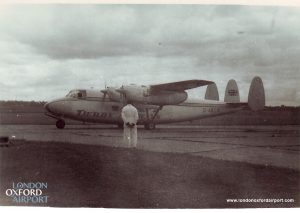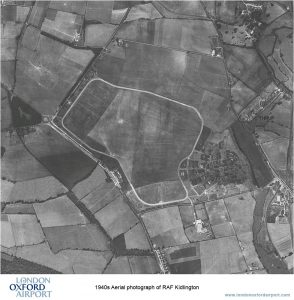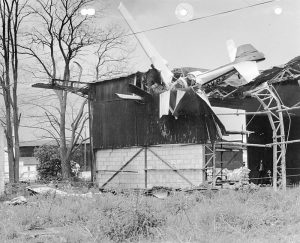London Oxford Airport – Key Milestones
Introduction
The site was first used as an aerodrome in the late 1930’s. From the mid-sixties, the airfield was best known as the home of CSE Aviation and the Oxford Air Training School (then Oxford Aviation Academy and latterly CAE), one of the world’s most successful professional pilot training establishments having trained well over 30,000 airline pilots for more than 90 airlines over the last 50 years. Today the largest professional pilot training operation is Leading Edge Aviation, established in 2018.
Although originally conceived as Oxford’s ‘Municipal Airport’, with the onset of the war, the airport turned to training thousands of RAF pilots. In the mid-forties there were a greater number of hangars and buildings than can be seen today with 15 acres of the original land having been sold off in the 1990s allowing the establishment of the Spires Business Park off Langford Lane (home of Elsevier and the Thames Valley Police HQ). Today the airport owns some 600 acres freehold with over 500,000 sq.ft. of buildings.
Oxford Airport is owned and operated by Oxford Aviation Services Limited (OASL). Since July 2007, OASL has been owned by Oxford Airport Acquisitions Limited, a subsidiary of Oxford Airport Holdings Ltd which ultimately is owned by Omaha Business Holdings Corp. Ultimately the airport is part of the Reuben Brothers group of businesses. In 2012 the group also acquired the London Heliport. The parent company has a varied portfolio of interests in property and several other diverse businesses.
Key Milestones:
Oxford’s very first years in aviation – pre OXF/EGTK
- 1784 – James Sadler became the first English aeronaut, making his first ascent in a balloon from Oxford University’s Christ Church Meadow on 15th September
- 1910 – Oxford’s Port Meadow (3.5 miles south) was granted flying rights for £10/annum to James Betts & Co. (Engineers)
- 1911 – The Imperial Aero Club was established – but all 15 aircraft and hangars were destroyed in a gale the same year!
- 1911 – Oxford’s Balliol College-educated celebrity French-born pilot Hubert Latham visited Port Meadow in his Antoinette monoplane
- 1919 – The Port Meadow aerodrome was closed
The beginnings of the current airport (OXF / EGTK)
- 1930 – Alan Cobham writes to UK city planning authorities (incl. Oxford City) encouraging them to build municipal aerodromes (Sept. 25th) – The Municipal Aerodrome Campaign
- 1932 – Editorial in the Oxford Times urged Council ‘to establish aerodrome to serve city.’ – ‘Civil aviation was developing with internal mail and air services.’ – ‘Those cities having an airport would reap direct benefits’.
- 1933 – Council approved establishment of ‘Municipal Aerodrome’ (May 8th)
- 1935 – Loan of £20,305 authorised by Ministry of Health to acquire 580 acres (Oct. 11th)
- 1935 – Land bought from Blenheim estate and two local farmers for £19,671 (Nov. 22nd)
- 1936 – Famous aviatrix Beryl Markham was the first person to fly solo non-stop across the Atlantic East to West, taking off from Oxfordshire to North America (Sept. 16th)
- 1937 – Air Ministry granted 12-year lease to establish RAF Volunteer Reserve flight training school
- 1937 – The local Cowley (Morris) factory was producing de Havilland Tiger Moths whilst also repairing damaged or crashed aircraft, including the reprocessing of wreckage of enemy Luftwaffe aircraft
- 1938 – First Miles Magisters, Hawker Hinds and Hawker Audaxes established
- 1939 – First Licensed for public use as Oxford (Campsfield) Civil Aerodrome though first listed as Thrupp airfield.
- 1939 – No.2 Group Training Pool (later No. 13 Operational Training Unit) first established by the Air Ministry at Oxford
- 1939 – Oxford Flying Club first established
- 1940 – No. 15 SFTS arrived from Brize Norton and had 134 Harvards and several Ansons and Oxfords based at the airport
- 1940 – First four bombs dropped from 50ft by Junkers Ju 88 on the airfield
- 1941 – A further (and final) 20 high explosive bombs were dropped on the airfield
- 1941 – Lord Trenchard on visiting Kidlington in May, announced that training activity on the airfield had accumulated 6,941 flying hours in just that one month, a milestone at the time
- 1941 – Famous aviator Amy Johnson (who flew solo in the Gypsy Moth from Croydon to Australia), disappeared on a flight from Blackpool destined for Kidlington on January 5th, ferrying an Airspeed Oxford. Believed to have crashed in the Thames estuary, neither the aircraft or Amy were ever found
- 1941 – Sir Winston Churchill, a regular visitor to nearby Ditchley Hall during the war and born at nearby Blenheim Palace, had the Duke of Hamilton fly into Kidlington to brief him personally on the previous day’s surprise arrival of a Messerschmitt Bf110 at the Duke’s Scottish home. On board was the Deputy Fuhrer, Rudolf Hess, who was attempting to broker a peace deal. The wreckage of the Bf110 was briefly displayed in Oxford city, before being whisked away in hindsight as a ‘Top Secret’
- 1946 – Airtraining (Oxford) Ltd, subsidiary of General Aircraft Ltd re-established after the war and merge as Universal Flying Services Limited
- 1947 – Oxford University Air Squadron moved from Abingdon to Oxford (Kidlington)
- 1947 – Oxford Flying Club resurrected as Oxford Aeroplane Club
- 1949 – Scheduled services established between Oxford and Jersey for £8 return
- 1951 – The final RAF unit at Kidlington, No.96 Maintenance Unit was disbanded

One of the first airline services at Oxford used the Miles M60 on a route from East Midlands to Jersey in 1958
- 1958 – An operation by Derby Aviation (latterly BMI Baby) flew a scheduled service from East Midlands to Oxford and on to Jersey using the Miles M60 Marathon (G-AMGW)
- 1958 – Oxford Aeroplane Club re-established as prime operator by Goodhew Aviation
- 1958 – Licensed hours extension granted for night operations
- 1959 – Flights to Jersey resumed with Dakotas at £11 return fare
- 1959 – Oxford Aviation Co. Ltd established with Rex Smith as CFI
- 1959 – Irish Air Charter (Lord Kildare) moved from Dublin and established as Vigors Aviation Ltd. as the UK Piper distributor going on to sell 1,500 of the make in the UK
- 1959 – The Air Ministry ceased to operate at Oxford returning airfield to full civil use
- 1960 – Oxford Aeroplane Club concluded transition from private to professional pilot training
- 1961 – Pressed Steel and Oxford Aviation Co. merge operations and established British Executive Air Services Limited (BEAS) selling Brantley helicopters and Beagle aircraft.
- 1962 – First fully integrated commercial pilot’s licences and instrument rating courses began. Danny Kaye, the entertainer, was one of the first students to train for the CPL
- 1962 – CSE Aviation founded (CSE) from former Vigors Aviation operations with Lord Kildare, Dick Hunt and Lord Waterpark as directors and owned by members of the Guinness family (Messrs Channon & Svejdar) and an American millionaire (Mr Erlanger) from whose surnames the initials CSE was derived.
- 1963 – Oxford Air Training School founded (OAT) derived from the BEAS Flying Training Division with Rex Smith as its principal.
- 1965 – OAT becomes the first school in the UK to be granted approval to conduct ab initio courses leading to the Commercial Pilot’s Licence and Instrument Rating
- 1966 – Halls of residence for 140 students built at entrance to airport
- 1967 – CSE signs 21-year lease of airport from the City Council at £7,000 pa.
- 1967 – Oxford has the only privately operated 4-engine jet simulator in the UK
- 1967 – British aviatrix Sheila Scott breaks over 23 world records flying around the world solo in a CSE-Aviation-supplied Piper aircraft. Ultimately, she broke over 100 records.
- 1968 – Oxford was second busiest airfield in the UK with 223,270 movements after Heathrow with 247,417 movements (but the busiest single runway in the world at the time)
- 1969 – OAT becomes first UK school to be granted approval for helicopter CPL ab initio training
- 1971 – OAT flies over 60,000 hours training flights in one year (was up to 150,000 hours in the late 1990’s)
- 1971 – Oxford’s CSE Aviation supplied and equipped Sheila Scott’s Piper Aztec in which she became the first pilot to fly solo over the north pole in a light aircraft having flown round the world three times, breaking over 100 records.
- 1972 – OAT had won training contracts for 46 major airlines and government bodies representing sixty-two countries.
- 1972 – OAT was the UK’s first educational establishment to obtain a Queens Award to Industry
- 1975 – Asphalt runway laid over original 1097m (3,600ft) grass strip
- 1976 – Engineering training school established
- 1981 – The airport freehold with 577 acres was sold by the council for £1.4m to CSE Aviation Ltd.
- 1986 – CSE Aviation Ltd was sold by the original founders to Oxford Aviation Holdings Ltd whose principal shareholder was Murray McLean, head of Robert Moss Ltd.
- 1987 – HRH the Duchess of York became the first lady in the Royal Family to receive her PPL from Oxford
- 1988 – Main runway lengthened to 1552m (5092ft / 0.96 miles)
- 1989 – New operations, training and control tower building erected
- 1990 – Airport acquired by AB Nyge Aero for under £20m
- 1990 – Shorts 330 scheduled service established to Jersey
- 1992 – McAlpine Helicopters are established at airport (now Airbus Helicopters)
- 1994 – OAT pioneers the use of computer-based training culminating in the award of the prestigious Flight International Aerospace Industry Award in 2002
- 1996 – CSE Aviation becomes the first general aviation company in the UK to gain ISO 9001 quality accreditation
- 1997 – The airfield, CSE and OAT as Oxford Aviation Services acquired by Close Brothers Group PLC for £21m
- 2000 – BBA Group acquired airfield, CSE and OAT as Oxford Aviation Services Ltd for £55.4m
- 2001 – OAT established as Europe’s largest training school with over 70 aircraft and 90 instructors with over 500,000 flight hours of combined teaching experience flying over 150,000 hours a year
- 2003 – OAT opens state-of-the-art instrument flight training centre
- 2003 – Licensed runway length increased by 10%
- 2004 – Airport opens dedicated business aviation terminal
- 2004 – Oxford Airport resident, Polly Vacher MBE, completes her second round the world flight via the poles, the first woman to do so in a single engined aircraft and the first to land on all seven continents.
- 2005 – Section 106 Agreement reached with Council on hours of operation (06:00-midnight) and total annual movements (160,000)
- 2006 – Two new hangars built totalling 37,000 sq.ft., the first for 30 years
- 2007 – Oxford Aviation Training launch Netjets cadet training scheme
- 2007 – Oxford Aviation Training sold to GCAT Flight Academy for £37m
- 2007 – Oxford Airport sold to Aldersgate Investments for £40m
- 2007 – Polly Vacher arrives at Oxford Airport to complete her ‘Wings Around Britain’ tour to all 221 UK airports
- 2007 – Airport completes new 1553m by 30m stronger runway
- 2007 – Airport installs Cat 1 Instrument Landing System
- 2008 – Airport builds new 8,000 sq.ft. executive terminal
- 2009 – Airport builds 21,000 sq.ft. ex-Easyjet 737-800 hangar
- 2009 – Airport gains Cat 5 rescue & fire capability
- 2009 – Jersey flights start with Air Southwest Dash-8
- 2009 – Awarded ‘Best Business Airport’ by Airport Operators Association
- 2009 – Airport introduces first ever international scheduled services to Geneva with Swiss regional airline Baboo on a Dash-8-Q400
- 2010 – Airport Upgrades to Cat 6 Fire & Rescue capability (A319/737-500)
- 2010 – Largest Hangar built to date at 48,000 sq.ft. – Hangar No.14
- 2010 – Aircraft parking apron increased by 4.4 acres (17,800m2)
- 2010 – Largest aircraft lands to date – an Embraer Lineage (EMB-190) – 119 ft long and 55 tonnes (100 seats)
- 2011 – Runway approved as Code 3C – Take-off distances increased up to 5,223 ft
- 2012 – New primary and secondary radar installed for the first time
- 2012 – Airport’s owners, Reuben Brothers, acquire the London Heliport
- 2012 – First new office block for 20 years built at entrance – 12,500 sq.ft.
- 2013 – Commercial air services were undertaken for a six-month period with Greek operator Minoan Airlines with services to Edinburgh and Dublin on Fokker 50 aircraft
- 2015 – The new Oxford Parkway rail station brings sub-1 hr central London connectivity to Kidlington and a little over an hour to the airport terminal
- 2019 – Jet Maintenance International (JMI) establish a dedicated Citation and Falcon MRO base in the newly built Hangar 14, Bay 4
- 2020 – The airport hosts both the heaviest aircraft seen to date, a C-130J at 70 tonnes and the longest, the EMB-195 at 41.5m
- 2020 – Leading Edge Aviation assumes the position as the largest of the training schools at Oxford
- 2021 – Seven new ICAO/EASA compliant helipads added to the ground infrastructure
- 2021 – A new £1m fuel farm is established increasing capacity four-fold and ready for future fuels like SAF
- 2021 – Largest hangar built to date, No. 15, is completed with 63,000 sq.ft. of hangar floor space and 7,000 sq.ft. of offices
- 2021 – Despite the ongoing Covid-19 pandemic, the airport was the 2nd busiest single-runway airport in the UK with 66,000 movements, second only to Stansted
- 2022 – Airport moves to full-time CAT 6 RFF (fire & rescue capability) enabling no-notice access for the largest types able to use the runway





